Home » Events
Category Archives: Events
Capturing the Moment: Swansea Stained Glass Archives
A symposium in Swansea on 24 November 2023 provided an opportunity to reflect on the remarkable achievements of staff and students of the Architectural Stained Glass department over recent decades. Dr Reinhard Köpf, an expert on German post-war stained glass, came from Düsseldorf to speak about the influential German artists who taught at Swansea in the 1970s and 80s as visiting artists. A panel discussion with some of the major figures in British architectural stained glass – Alex Beleschenko, Amber Hiscott and Rodney Bender – recalled their time in Swansea College of Art and the German artists who were invited over to Swansea by Tim Lewis, head of the stained glass course from 1972 until 1995.
An impressive display of stained glass panels, drawings and archive photographs from the college collection was set up by Christian Ryan with Owen Luetchford and Stacey Pountney of the Architectural Glass Centre. The afternoon presented an opportunity to assess the research potential of this archive along with others in Wales. We were joined by the curator of the Stained Glass Museum, Dr Jasmine Allen, Kim Collis of West Glamorgan Archive Service and Felicity Grey, Archives and Records Officer for UWTSD.
After our day considering the stained glass archives at Swansea College of Art and the legacy of the teaching of architectural stained glass at Swansea College of Art, a visit to Coychurch Crematorium presented an opportunity to see the extraordinary collection of artworks made by staff and students of the college for one of the most remarkable Modernist crematoria anywhere in Britain.
Several artists spoke about their involvement designing and making stained glass for the crematorium, the first of which was completed in 1970 by Roger Hayman. Roger was able to join us, as well as Rodney Bender, who worked on the windows by Ludwig Schaffrath, Johannes Schreiter and others. Alex Beleschenko brought along some of the original drawings for his set of panels around the door to the chapel, and Christian Ryan spoke about his series of windows in the chapel.
New works in glass have recently been made by Rodney Bender for a new exterior courtyard, so the series of commissions in glass at the crematorium span a period of more than fifty years.
Grateful thanks are due to Joanna Hamilton, the manager at the crematorium, for providing the opportunity to visit, and Christian Ryan for making arrangements. I will be preparing a book on the stained glass at Coychurch Crematorium in 2024, collaborating with other experts and artists.
New research, events and publications 2022–3
July 2023
Although the dearth of new material on this blog would suggest otherwise, there have been many events and new publications to report on from the last twelve months or so – but little time to detail them here.
I hope to add some details on these activities and a selection of some new discoveries made while completing Welsh Saints from Welsh Churches, which was published earlier this year. For this book, and a selection of spreads, see this page on my website.
Further articles on the imagery of saints in Wales were published in an edited collection of new writing about saints in Wales in 2022, and a further article on the work of Celtic Studios is forthcoming this year.
There have also been new books on the stained glass in the Welsh port towns of Fishguard and Holyhead. I will try and add the material in as chronological an order as possible, although I may well get distracted by more recent events.
A War Memorial Window by Alice Meredith Williams at Bassaleg
In June 2023 I gave talks at a couple of churches as part of the Churches Unlocked Festival, a series of events across the dioceses of Llandaf and Monmouth. In addition to talks and performances, churches were open to visitors over the weekend and some were open for the whole of the two-week period of the festival.
Giving talks at churches is often a two-way exchange. I can share information on the makers, subjects and commissioning of windows and also glean further information and hear additional stories about the stained glass in these buildings from those that attend.
Having prepared a talk on the windows that can be found at the Church of St Basil, Bassaleg, near Newport, I was unprepared to find a booklet concerning one of the windows produced to mark an event at the church in November 2022. I was delighted to find that the booklet revealed the identity of the artist behind a window that has puzzled me for many years since I first visited the church in 2011.
The window commemorates Lieut Col C.J. Wilkie and officers, NCOs and men of the seventeenth battalion of the Welch Regiment, and has three main figures of the archangel Michael and the saints George and David. At first glance it appears to be a fairly conventional late Gothic Revival war memorial window, with standing figures, angels and heraldry. I included it as an example of the combinations of saints found in First World War memorial stained glass in Stained Glass from Welsh Churches in 2014, although I was uncertain about attributing the window.
In the Buildings of Wales volume for Gwent/Monmouthshire, by the late John Newman and published in 2000, it is suggested that the window was probably by Martin Travers. The aesthetic of the window bears some relation to his work, but Travers’ biographer, Micheal Yelton, had confirmed that the window was not by him. The suggested attribution of the window to Travers was provided by Alan Brooks, and prior to the publication of Stained Glass from Welsh Churches I sent him my photo of the window and asked him about it. Seeing the window again he replied that he was of the opinion that the work could be by J.C.N. Bewsey, and although I had sight of only a few windows by him, I tentatively attributed the window to Bewsey, a former employee at the studio of Charles Eamer Kempe.
I was never very happy with this attribution and looked very hard at it again before including a detail of St David in my book Depicting St David in 2020. I had only come across a few more windows by Bewsey in the intervening time and their style differed from this one. I left the illustration unattributed in the new book and placed it in the context of other windows of St David designed and/or made by Herbert Bryans, Frederick Eden, William Bucknall and Ninian Comper. It seemed quite at home in this company and I mused on these designers working in partnerships with other designers and studios in the first quarter of the twentieth century, making stylistic attributions rather difficult. For example, Eden’s windows were made by James Fisher of Fulham before Eden oversaw the making of his windows in his own studio, presumably with different craftsmen; and although I found a newspaper report identifying the architect William Bucknall as the designer of the figures for the east window at Milford Haven, including David, there was no mention of the studio that had made the window.
The main figures and borders of the window at Bassaleg were all quite conventional, although the faces of the three saints and the angels were more distinctive, especially the heads of St Michael and some of the angels with their slightly wild and tightly curled hair. The colouring was brighter and the white glass whiter than in much stained glass made at the time, in common with work of the same period designed by Eden, Comper and Geoffrey Webb.
The booklet at the church in Bassaleg was produced for a rededication of the window on 26 November 2022. It includes a description of the window from the Western Mail (dated 19 February 1921, following the official unveiling more than two years after the completion of the window), a brief history of the battalion commemorated and information about the making of the window. This reveals that the window was designed by Alice Meredith Williams, whose husband Morris Meredith Williams was also an artist and had joined the battalion in 1915. They had met Lieut Col Charles J. Wilkie, named on the window, and his wife Dora while the battalion trained in Wales and England; Charles and Dora had married in the church at Bassaleg in 1897.
Alice Meredith Williams was commissioned to design the window in 1917 and it was made by E.& C. O’Neill of London, who painted the window and had it made and fixed. Intriguingly, the booklet states that she had consulted J.C.N. Bewsey, so the similarities with his work are not coincidental. He had offered to take the project on, and although Williams kept the commission (despite not charging for her work) she followed some of his advice on the design and he recommended the firm of O’Neill’s to her.
E. & C. O’Neill are not a studio whose work I have come across in Wales before. They made windows for other designers including another former employee of C.E. Kempe, C.E. Tute, who shared his address with them at 165 Grays Inn Road. O’Neill’s also appear to have operated from 103 Grays Inn Road, and by 1914 they were based nearby at 4 Heathcote Street, Mecklenburgh Square.
It is possible that the studio made the only window by Tute that I know of in Wales, the remarkable window of 1897 including St Paul preaching to Caractacus and Bendigeidfran at Llandinam. In 1897 Tute was based at 4 Grays Inn Square, close to the addresses occupied by O’Neill’s, and the studio made a scheme of windows for Tute at Crantock in Cornwall shortly after this date, including an impressive east window.
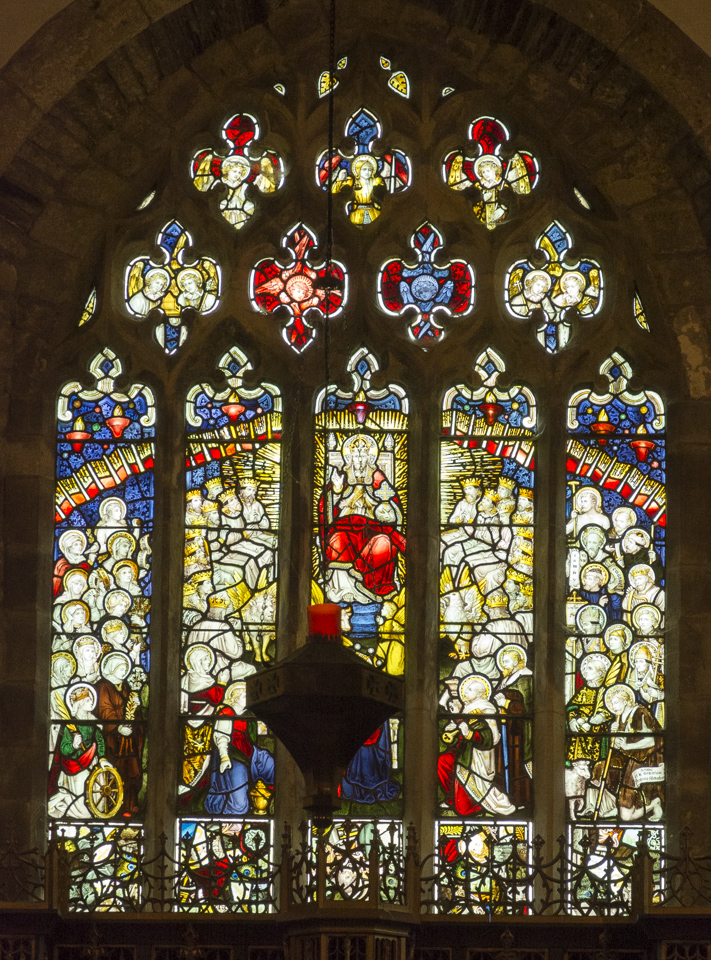
The window at Bassaleg was illustrated in Phyllida Shaw’s excellent book on Alice and Morris Meredith Williams published in 2017, and according to the little booklet at the church Phyllida Shaw attended and spoke at the event for the rededication of the window in 2022. Her book, An Artist’s War: The art and letters of Morris and Alice Meredith Williams, provides ample evidence of the importance of Morris Meredith Williams as a First World War artist, while he served in the same battalion as Charles Wilkie.
Alice Meredith Williams was primarily a sculptor and also drew and painted. Perhaps her most significant work was for the Shrine of the Scottish National War Memorial at Edinburgh Castle, where her the frieze is placed beneath windows by Douglas Strachan; she also made further figures for the building and other powerful monumental sculpture in the aftermath of the First World War. Alice and Morris Meredith Williams designed further windows for churches in Scotland, as well as a set of windows for Bermuda Cathedral. These other windows, as well as others by designed by Morris after Alice died in 1934, look like the work of other makers, probably one of the studios in Scotland that flourished under the influence of the Arts and Crafts Movement in the first half of the twentieth century. Her initial recourse to Bewsey would suggest that the window at Bassaleg was her first window.
The memorial window to Lieut Col C.J. Wilkie and the seventeenth battalion of the Welch Regiment at Bassaleg represents an excellent example of the occasional partnerships and collaborations between particular artists, designers and studios, which can only be tracked down through archival work. These are the kind of windows that usually elude stylistic attribution – in this case it is perhaps the only example of a window by the artist being made by the studio, perhaps making it unique.
Notes
Information on the addresses of E. & C. O’Neill and C.E. Tute is from the ‘Architects and Artists’ section of Sussex Parish Churches; Joyce Little, Stained Glass Marks and Monograms ed. Angela Goedicke and Margaret Washbourn (National Association of Decorative and Fine Art Societies, 2002); and an article on the scheme at Carantoc by Michael G. Swift and Jeni Stewart-Smith on the Cornish Stained Glass site.
For Alice and Morris Meredith Williams, see:
Phyllida Shaw, An Artist’s War: The art and letters of Morris and Alice Meredith Williams (Stroud: History Press, 2017).
Phyllida Shaw, Undaunted Spirit: The Art and Craft of Gertrude Alice Meredith Williams (Independent Publishing Network, 2019).
St David panels at Cardiff Cathedral
It feels a long time since last week. At the end of February I was in discussions to hold a launch of Depicting St David at the Metropolitan Cathedral Church of St David in Cardiff, and although events were beginning to be cancelled or postponed, on Monday 16 March 2020 I gave a short talk after the lunchtime Mass to a small gathering. That afternoon, new government advice discouraged all events of this type and events for St Patrick’s Day on the next day were cancelled. Within days all church services were suspended until further notice as a result of the pandemic, prior to the requirement for us all to stay at home.
The reason why it seemed appropriate to hold a launch of the book at the cathedral – albeit not in such circumstances – was the presence of a unique set of scenes of the Life of David in the sanctuary. Two pairs of two-light windows contain eight scenes from the Life of David, more than any other set of scenes depicting David that I have come across in any other churches.
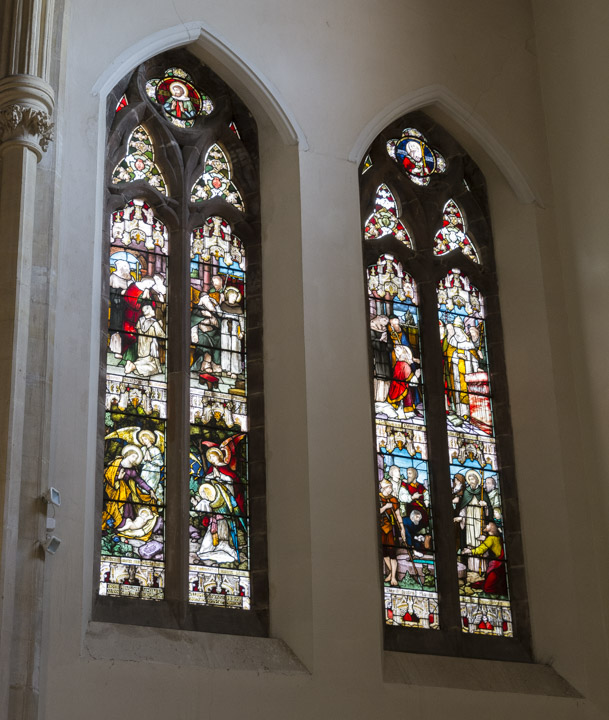
Mayer & Co., Scenes from the Life of St David, c. 1900, Cardiff Cathedral 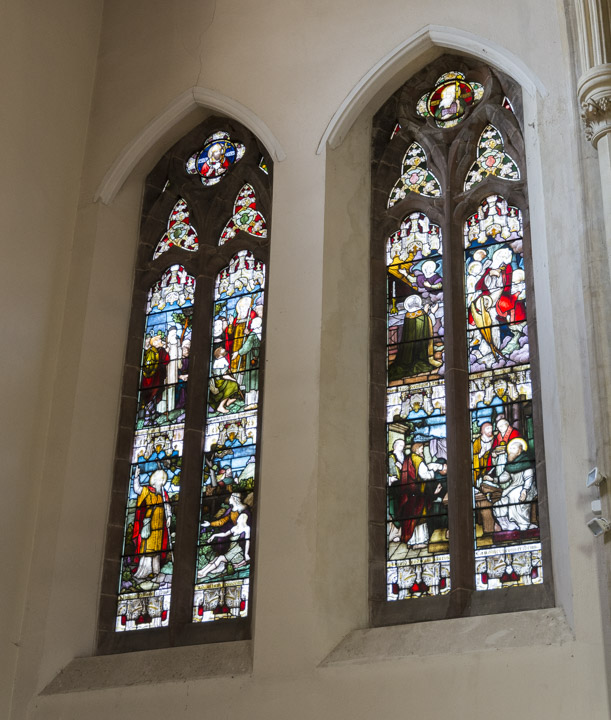
There is however some uncertainty surrounding the windows. The devastation of Llandaff Cathedral, not far from the city centre, in the Second World War and its subsequent restoration in the 1950s is well known, but St David’s, built as a parish church for the centre of Cardiff in 1885–6, also suffered, and was gutted by an incendiary bomb in 1941.
In June 1897, The Tablet reported on the intention to fill the windows of the chancel with stained glass depicting the saints. David, Teilo, Iltud, Cadog and other local saints, as a memorial to the Vicar-General, the late Monsignor Williams. Although small roundels of Dyfrig, Patrick, Illtud and Teilo are found in the upper tracery lights, the scenes in the windows now are all of David, with Latin inscriptions. Teilo does appear in one of the windows, but in the context of his visit to Jerusalem with David and Padarn, where they are consecrated as bishops.
The survival of these windows in situ, given the terrible destruction of the sanctuary in 1941, seemed unlikely, and I had wondered whether the windows had been saved from four of the two-light windows in the nave and moved there when the cathedral, which had been largely derelict for most of the 1940s and 50s, was restored in the late 1950s. The windows are commensurate with a date of around 1897, and the work of Mayer of Munich. I spoke to Canon Peter Collins, formerly dean of the cathedral, who thought that the windows had indeed survived the bombing in their present position. In support of this possibility, a small amount of stained glass can be seen in a photograph of the interior. It may of course be possible that the original intention to fill the windows with scenes or figures of Teilo, Illtud and Cadog in June 1897 was changed, and a set of scenes of the Life of the patron of the church would have been very appropriate.
My visit to the cathedral afforded me the opportunity to look more carefully at the windows now in the sanctuary, which revealed a couple of important discoveries. Firstly, the inscription to Mgr Williams remains at the foot of one of the windows on the north side, and all of the windows have lost a number of pieces of glass, including some figures, which have been replaced, although the majority of the panels are intact. An amount of restoration would be expected given the long period in which the church stood derelict.
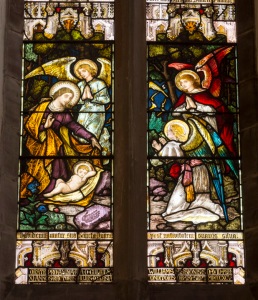
Mayer & Co, The Birth of St David, with angels, one of whom has a replacement head and upper body, and inscription to Mgr WIlliams below. 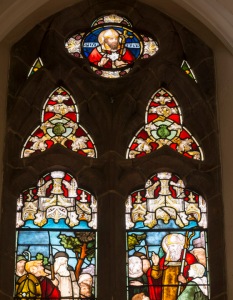
St David Preaching at the Synod of Victory, with tracery lights and roundel of St Dyfrig.
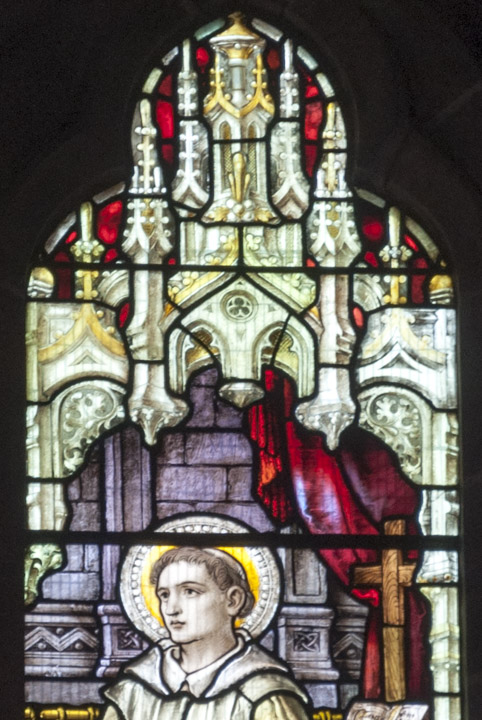 However, comparing the very small amount of stained glass, faintly visible at the edge of the photograph taken after the bomb fell in 1941, with what is in that window now, seems to show that the glass that is there now was not there then. Furthermore, the foliate tracery lights do not clearly match the architectural tops of the present windows, which might suggest that these are the original tracery lights, with the scenes of St David inserted in the 1950s from elsewhere in the church. Although the inscription is present, its continuity with the surrounding glass is not altogether convincing, and could have been inserted into the lower decorative panel at the time of restoration. Some of the two-light windows in the nave have no stained glass, and the main lights are of a similar width and appear to be only slightly taller than those in the sanctuary. Correspondingly, the design of the architectural canopies in the tops of the main lights of the sanctuary windows seem slightly truncated, which would have been necessary if they had been moved from the nave windows, where the upper part of the arched top is taller.
However, comparing the very small amount of stained glass, faintly visible at the edge of the photograph taken after the bomb fell in 1941, with what is in that window now, seems to show that the glass that is there now was not there then. Furthermore, the foliate tracery lights do not clearly match the architectural tops of the present windows, which might suggest that these are the original tracery lights, with the scenes of St David inserted in the 1950s from elsewhere in the church. Although the inscription is present, its continuity with the surrounding glass is not altogether convincing, and could have been inserted into the lower decorative panel at the time of restoration. Some of the two-light windows in the nave have no stained glass, and the main lights are of a similar width and appear to be only slightly taller than those in the sanctuary. Correspondingly, the design of the architectural canopies in the tops of the main lights of the sanctuary windows seem slightly truncated, which would have been necessary if they had been moved from the nave windows, where the upper part of the arched top is taller.
Whether or not these windows are in their original position, and whether or not we have lost scenes of other local saints, these eight scenes include images of certain episodes in the Life of St David that are not found anywhere else, and are therefore a fortunate and important survival.
In Glass Thy Story
On 8–9 September I attended the Art and Christianity Enquiry (ACE) symposium in Cambridge: ‘In glass thy story‘, a two-day symposium addressing over 70 years of innovation and iconography in the glass art of British and European churches and cathedrals.
On the first day I contributed a paper on the change in direction that prompted the adoption of a more vivid and bold approach to stained glass design in the Llandaf diocese. This enlarged an observation made on pages 268–9 of Stained Glass from Welsh Churches, and presented the opportunity to show the work of Welsh artists Howard Martin, John Edwards, Tim Lewis, John Petts and others to a distinguished gathering of British and continental artists and scholars.
The symposium was held at Robinson College, Cambridge. This presented the opportunity to see works by John Piper and Patrick Reyntiens in the chapel of the college, one of which is a small and intimate window, the other a large and ambitious work occupying much of the wall behind the altar. After my lecture, the proceedings continued with a short performance by the pianist Patrick Hemmerlé in the chapel, offering the opportunity to contemplate the work in conjunction with music by Debussy and Ravel.
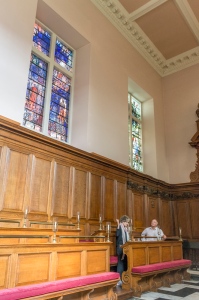
Tom Denny and Sophie Hacker discussing his work in St Catherine’s College Chapel, Cambridge, with his recent window above.
The opportunity to engage with another recent work in Cambridge was provided by a visit to St Catherine’s College Chapel, where the artist Tom Denny spoke about his work in conversation with Sophie Hacker, and in particular about his window in the chapel.
The final talk of the conference was about the windows designed by the abstract artist John McLean for Norwich Cathedral, installed since I last visited the cathedral. As I came away I couldn’t help thinking about the striking difference between these wholly abstract windows, saturating their aisle with colour, with the window we looked at by Tom Denny. This was also a work which was rich in colour, and might, in combination with two other windows in a similar kind of location, have also created a colourful immersive environment. But the work of Denny was figurative and suggestive, an intelligent interpretation of texts from Ecclesiastes, and also brilliantly painted.
Were the windows by John McLean, with their absence of any apparent message, suggestive of a church that does not know what to say anymore, or at least a church that chooses to say little? In glass no story?
Such things cannot be argued one way or another in a few lines here. I didn’t talk about theology or narrative in my talk and lots of us were perhaps on safer ground with style and form. But the rare opportunity to think about these things at the ACE conference was a welcome one.
Stained Glass Museum Study Weekend 2017
It was good to revisit some churches in north Wales, and see some new places in Cheshire, while acting as a guide for the Stained Glass Museum Study Weekend, alongside Jasmine Allen and Penny Hebgin-Barnes.

A.L. Moore & Son, Crucifixion with the Supper at Emmaus, probably early twentieth century, Emmanuel Church, Bistre
The opportunity to see new things in familiar places, with the help of a knowledgeable and observant group of people, ensured that all of us went away with something new. In familiar churches there were some things that I had not seen before. In the case of the two churches in Buckley for instance, there were windows that were not there the last time that I visited: at St Matthew’s a new little window painted by Deborah Lowe has been added, and a window by A.L. Moore from a closed church in Manchester has found a new home in Emmanuel Church, Bistre.
As the tour included churches and private chapels that I had not visited before, there were a few things in particular that I learnt from the trip, and here are three of them.
1. The work of the big studios such as Heaton, Butler and Bayne could be tremendously diverse.
Well, that’s not a great start because I already knew that, but it was underlined by the work of this firm that kept cropping up at a number of the places that we visited. This seemed especially noticeable as we were fortunate to start at Eaton Hall Chapel, where the entire scheme of windows was made by the firm, but to the design of Frederic Shields, who evidently excercised considerable control over its production. These windows bore none of the recognisable features of stained glass by the firm, and at successive churches – Rossett, Gresford, Malpas, Llanfarchell as well as at Chester Cathedral – we found their work in a wide variety of styles from the 1870s to the 1920s.
Incidentally, on my return I found some similarities between a few of the poses found in the Eaton Hall Chapel glass and a window I know better, the east window at Llanbadarn Fawr, which Frederic Shields designed with J. P. Seddon and was made by Belham & Co in 1884.
2. There are very close parallels between some of the Flemish panels at Cholmondeley Castle and those at Llanwenllwyfo
I have written about the collection of Flemish glass from the Neave collection, now at Llanwenllwyfo, Anglesey, on these pages and elsewhere. While researching the Llanwenllwyfo glass I have come across references to, and a couple of small illustrations of, the stained glass now at the private chapel of Cholmondeley Castle, so once again, although the above statement was not really new to me, the chance to see the stained glass at Cholmondeley enabled me to see this for myself and make some further observations (too many to detail fully here).
The design of six scenes now in the east window of Cholmondeley Castle Chapel is very close to some of those at Llanwenllwyfo such as Christ with Veronica, the Raising of Lazarus, Abraham Visited by Angels and David with Abigail. These were probably made in Leuven and may have come from the Charterhouse there. As well as the overall design of the panels, some of the figures are painted in a closely related style, and probably by the same workshop, and there are two examples of lettering used on the edges of garments to state the names of certain figures, found in several panels at Llanwenllwyfo.
The detail illustrated here shows this and also the problems of identifying artists. It would seem that the head of the unfortunate prophet here does not match any of those at Llanwenllwyfo closely, but it also differs from that above it and the group to the right, raising the possibility of three hands at work in this single panel.
The heads of Samuel from Cholmondeley and of Simon the Pharisee at Llanwenllwyfo offer an example of a pair of heads that seem to match very closely, but not quite exactly. Since we really know very little about these panels, they could be by the same artist but separated by a number of years, by different painters in the same workshop, or the product of different workshops but closely following the work of the same designer. Whether they were originally made for the same location we will probably never know.
Three of the scenes at Cholmondeley retain their lower inscriptions, which may assist with further work on their origin and the workshops responsible for them, although none have any borders at their sides.
Finally, as an additional parallel to the stained glass at Llanwenllwyfo, a roundel at Cholmondeley also depicts Christ wearing a hat and holding a spade as he encounters Mary Magdalene after the Resurrection, a scene that is particularly distinctive at Llanwenllwyfo and was featured on the cover of the book about that church and its glass.
3. The firm of Ballantine of Edinburgh underwent a huge transformation in the first quarter of the twentieth century, or perhaps they didn’t
Visiting the Church of St Oswald, Malpas, brought me back to a window that had struck me on my first visit, a four-light window of the Adoration of the Magi. After I first saw the window I was surprised that the Pevsner (Clare Hartwell, Matthew Hyde and Nikolaus Pevsner, The Buildings of England: Cheshire, 2011) tentatively attributed the window to Ballantine of Edinburgh. Shortly before this discovery I had also been surprised that Peter Cormack, in his review of my little book on the stained glass at Tenby, had also suggested the firm as the maker of a window that I had been unable to attribute there.
Comparison of some of the faces in both windows suggests that they could perhaps have been by the same artist, although there was a little more painted shading in the little Tenby window. But were either of the windows products of the studio of Ballantine?
James Ballantine & Son (also Ballantine & Allen, and later Ballantine & Gardiner and then A. Ballantine & Son) was a long-lived firm that was established in Edinburgh by the 1830s and made stained glass for the House of Lords. Windows by the studio of the 1850s and 60s are found in north Wales, demonstrating a strong pictorial style with very fine painting and bright colours, but, by 1881, their window at Emmanuel, Bistre shows a duller colour palette in keeping with the times. A further window of 1890 at the Church of St Mary, Lenten Pool, Denbigh, also on our tour, demonstrates a very much more conventional Gothic Revival style typical of the period.
So after that recognisable change of approach, might they have embraced a style more in keeping with some of the best artists associated with the Arts and Crafts Movement so convincingly that they were able to produce the beautiful window at Malpas? Many on the tour thought not, but no other attributions were forthcoming.
St David by Heaton, Butler & Bayne
On Saturday 1 April the ‘Cult of Saints in Wales’ project collaborated on an afternoon of talks about St Padarn and the saints of Wales at the Church of St Padarn, Llanbadarn Fawr. My short talk focussed on three south transept windows of the 1930s by Heaton, Butler & Bayne, which depicted the saints Padarn, Teilo and David.
According to the Lives of all of these three saints, they journeyed to the Holy Land together, where they were met, and given gifts, by the patriarch of Jerusalem. As we were specifically remembering Padarn in the church that bears his name, I showed some more images of Padarn in other churches, but also took the opportunity to show windows of other saints by the studio of Heaton, Butler and Bayne.
When looking through my archive, I found a series of images of David, patron saint of Wales, made by the firm from the late 1880s up until the one at Llanbadarn Fawr of about 1930. What is interesting about all of these figures is that even though they use more or less the same kind of figure, none that I have seen are repeats of another, using the same cartoon. This use of the same cartoon for multiple windows is of course well-known among all stained glass studios, from Hardman’s to Morris & Co. to Celtic Studios and even some of the finest individual artists in the medium, such as Christopher Whall and Karl Parsons reused designs and cartoons. Note the range of unusual headgear provided for the saint, not a mitre in sight!
‘Heavenly Lights’ Exhibition
I have mentioned the upcoming exhibition of the work of Margaret Rope at Shrewsbury Museum and Art Gallery on these pages before, and I was pleased to be able to attend the private view for the exhibition on 9 September.
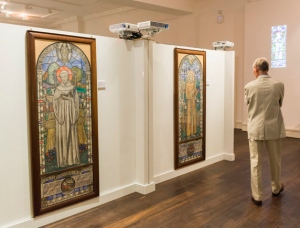 This innovative exhibition includes drawings, cartoons and projections of many of her windows, as well as work in glass and sculpture. The exhibition includes coloured cartoons of all three of her windows in Wales, the pair of saints at Llanarth in Monmouthshire and the memorial window to her niece and nephew at Llandovery, who both died in childhood.
This innovative exhibition includes drawings, cartoons and projections of many of her windows, as well as work in glass and sculpture. The exhibition includes coloured cartoons of all three of her windows in Wales, the pair of saints at Llanarth in Monmouthshire and the memorial window to her niece and nephew at Llandovery, who both died in childhood.
This exhibition view shows the Llanarth cartoons with (just visible!) my photograph of St Bernard projected on the wall. Also at the exhibition is a cartoon of the window depicting St Winifrede at the Church of St Peter and St Paul, Newport, Shropshire, which found its way to the museum at Holywell at some stage in the past, and has been lent by the Diocese of Wrexham.
I also took the opportunity to visit Shrewsbury Cathedral, where there are seven windows by Margaret Rope. and I will post a further piece about the imagery of Winifrede on the Saints in Wales project website.
I will be back in Shrewsbury, on the 17 November, if not before, to give a talk about David Evans, another important artist with Shrewsbury connections, for the Friends of Shrewsbury Museum. The exhibition continues until 15 January 2017.
The Jesse Window explained
The new window by Helen Whittaker for Abergavenny is described, with some justification, as ‘one of the greatest new works of church art in Wales since the Second World War’ on the Church in Wales website.
A crowned figure at York Minster dating to the mid-twelfth century is sometimes described as the earliest surviving painted panel of window glass in Britain, and probably came from a Jesse window. Other important medieval survivals include the later Jesse windows at York and Wells, as well as the most complete medieval window in Wales, at Llanrhaeadr-yng-Nghinmeirch, dating from 1533. But the subject is still returned to. The big east window of the Lady Chapel at Llandaff Cathedral also features the Tree of Jesse, and since it was made by Geoffrey Webb in 1951, it might also claim to be one of the most important commissions for church art in Wales. But in truth, there are plenty of others to choose from, such as Jacob Epstein’s Majestas in Llandaff, and other outstanding windows on the same scale or of the highest quality, but they are just not so well known.
The new window will be dedicated on 7 July by the Bishop of Monmouth.
St Mary's Priory Church, Abergavenny
As the the new window, designed by Helen Whittaker, is installed Canon Mark Soady reflects:
Stained glass windows came in to being in Medieval times as a means of educating the largely illiterate public about the Good News of the Bible through visual images.
Helen’s window does an amazing job in encapsulating the various themes and messages that run through the Bible. It will be a great aid to teaching and a wonderful compliment to the Jesse artefact itself.
The starting point for Helen’s design is the ‘centrality of Christ as God and man’. The dual aspects of Christ are explored through images and relationships connected with the five principal themes: Christ, Kingship, Prophecy, the Church and the Sacrament.
At the top of the tree sits the Virgin Mary with the Christ child on her knee. They are shown to a larger scale then other figures in the window, recognising…
View original post 648 more words

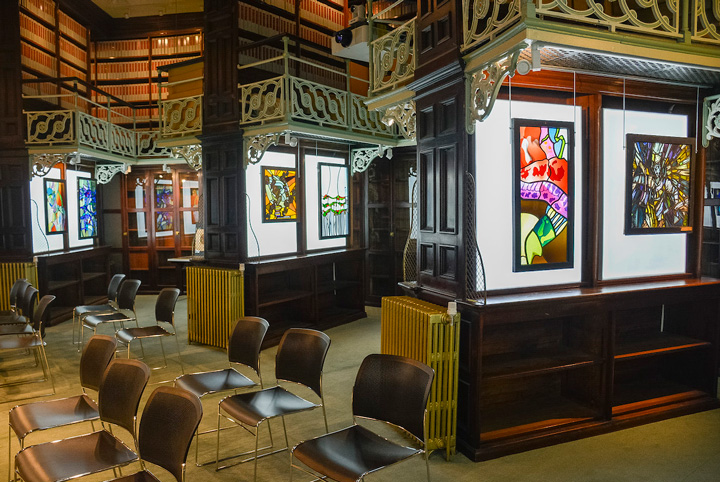
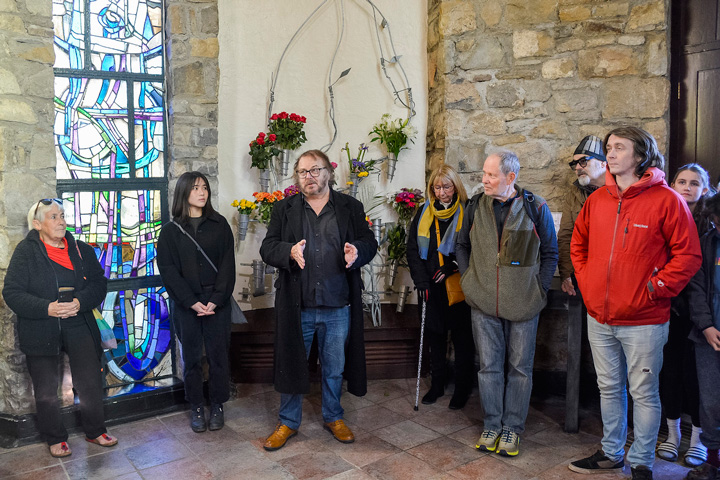
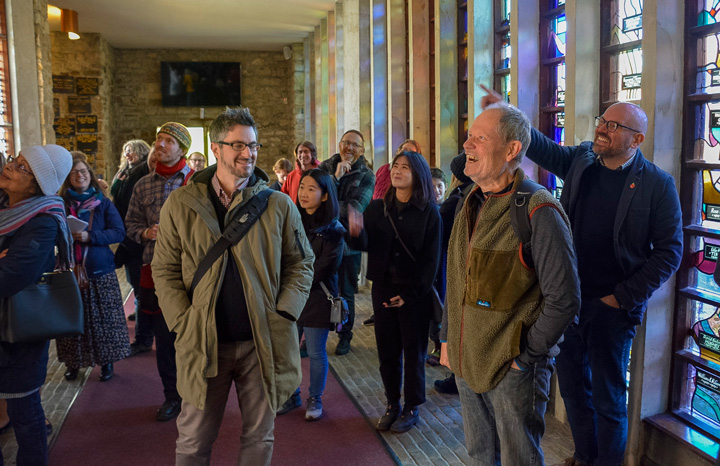
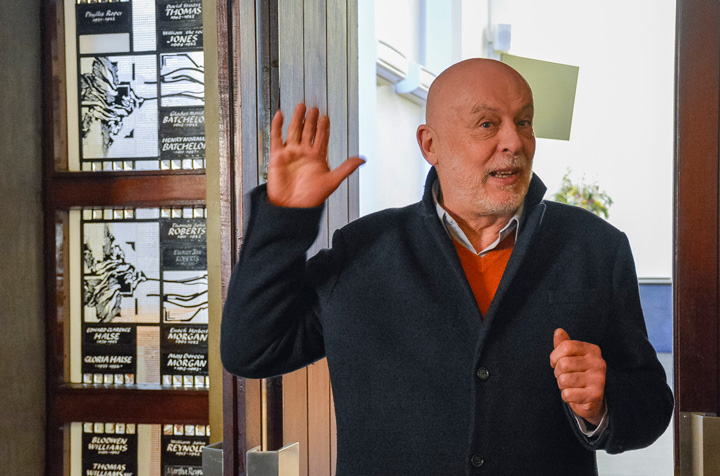
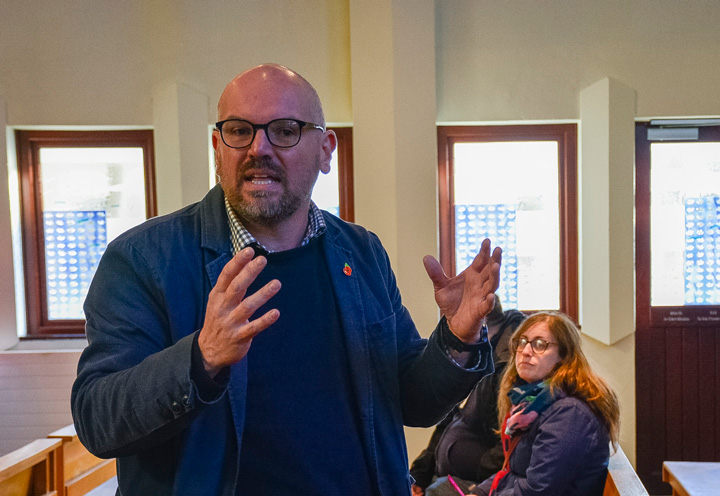
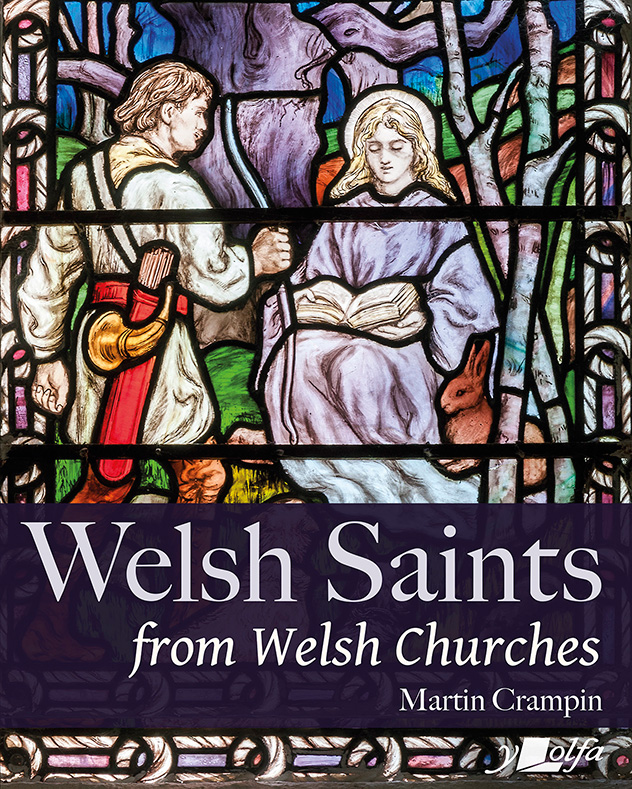
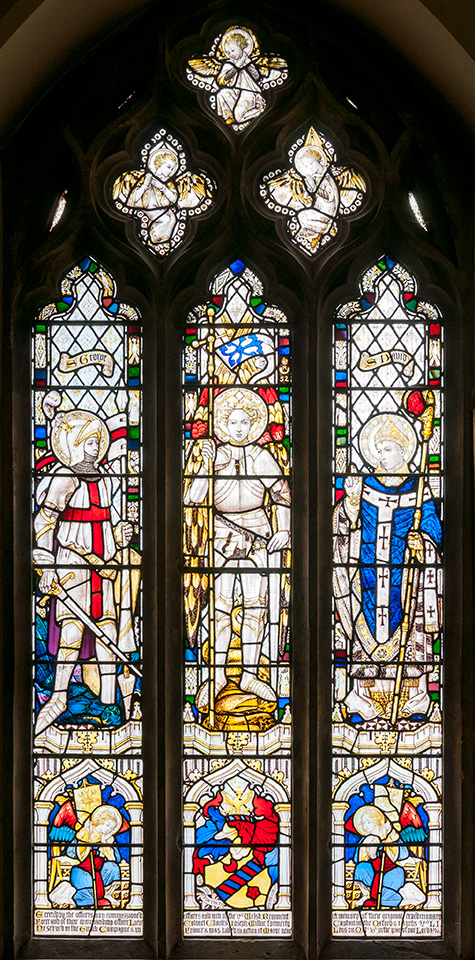
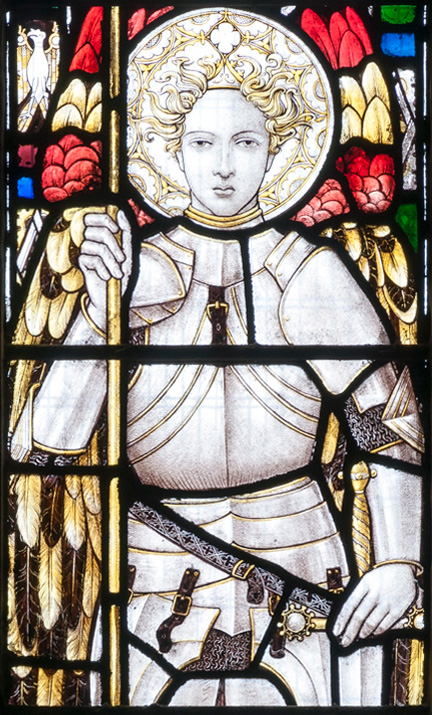
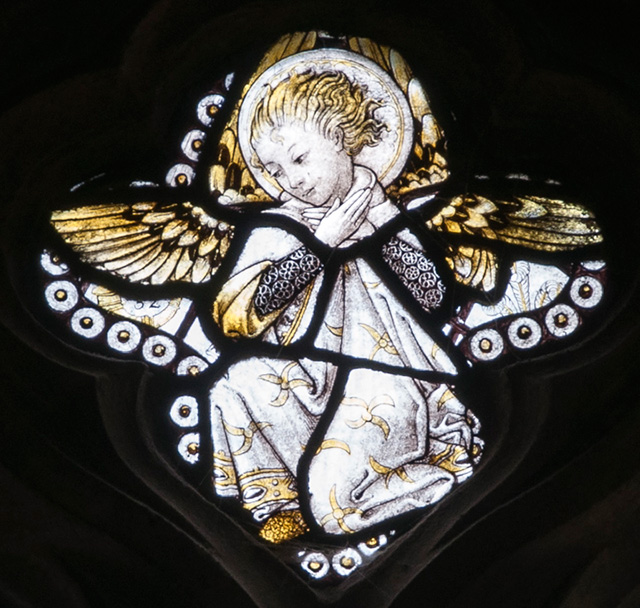
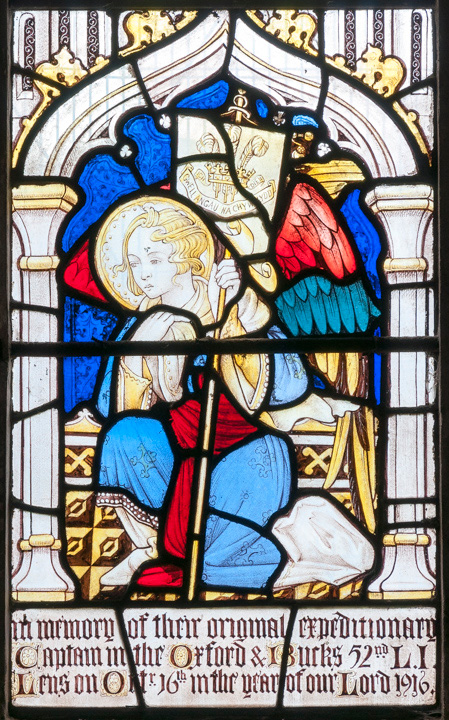

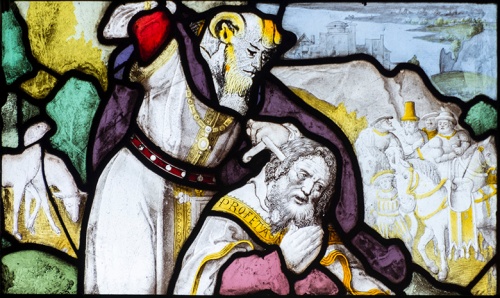

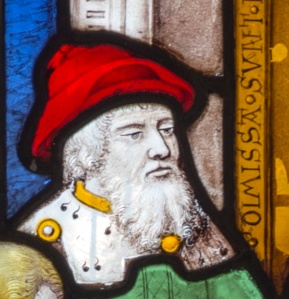
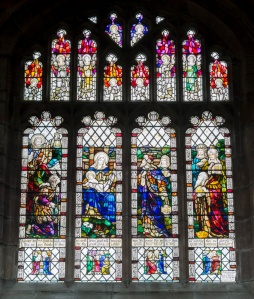
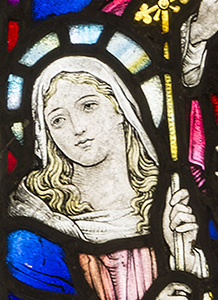

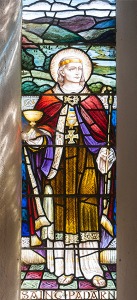
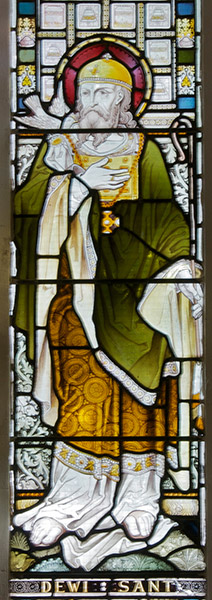

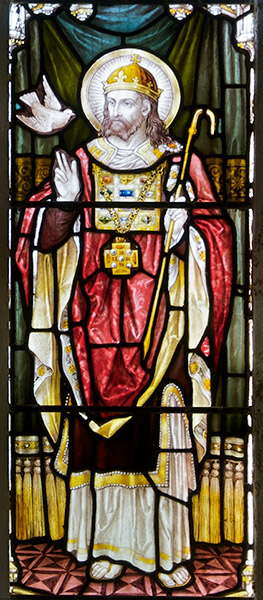
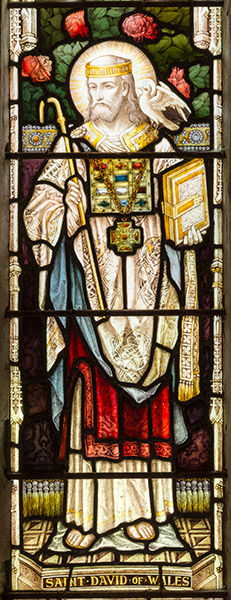
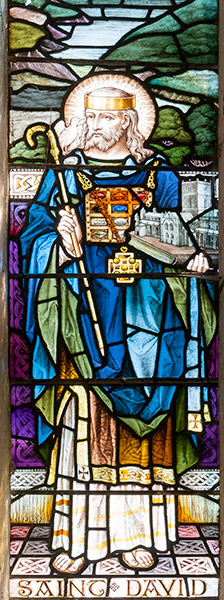
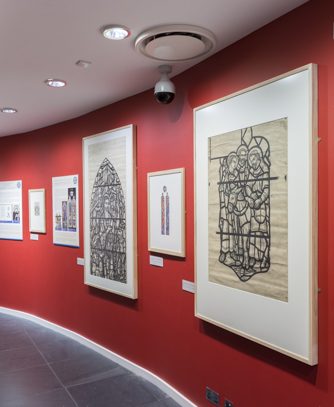 As part of my work on ‘
As part of my work on ‘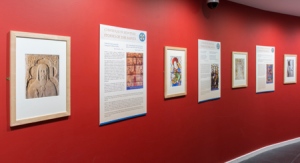 I designed the exhibition displays which include my photographs of modern and medieval images of saints, and some of these are displayed as framed prints. To coincide with the exhibition, I will be speaking at the National Library about images of saints from churches in Wales on 17 May, as well as doing a gallery talk on 29 March.
I designed the exhibition displays which include my photographs of modern and medieval images of saints, and some of these are displayed as framed prints. To coincide with the exhibition, I will be speaking at the National Library about images of saints from churches in Wales on 17 May, as well as doing a gallery talk on 29 March.